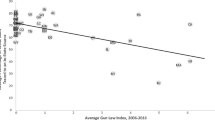Abstract
The practices of licensed gun dealers can threaten the safety of urban residents by facilitating the diversion of guns to criminals. In 2003, changes to federal law shielded gun dealers from the release of gun trace data and provided other protections to gun dealers. The 14-month period during which the dealer did not sell junk guns was associated with a 68% reduction in the diversion of guns to criminals within a year of sale by the dealer and a 43% increase in guns diverted to criminals following sales by other dealers. The laws were associated with a 203% increase in the number of guns diverted to criminals within a year of sale by the gun store, which was the focus of this study. Policies which affect gun dealer accountability appeared to influence the diversion of guns to criminals.


Similar content being viewed by others
References
Cook PJ, Ludwig J, Braga AA. The criminal records of homicide offenders. JAMA. 2005; 294: 598–601.
Harlow CW. Firearm Use by Offenders. Bureau of Justice Statistics Special Report. Office of Justice Programs. Washington, DC: US Department of Justice; 2001.
Webster DW, Freed LH, Frattaroli S, Wilson MH. How delinquent youth acquire guns: initial versus most recent gun acquisitions. J Urban Health. 2002; 79: 60–69.
Braga AA, Kennedy DM. Illicit acquisition of firearms by youth and juveniles. J Criminal Justice. 2001; 29: 379–388.
Bureau of Alcohol, Tobacco, and Firearms. Commerce in Firearms in the United States. Washington, DC: US Department of the Treasury; 2000.
Bureau of Alcohol, Tobacco, and Firearms (ATF). Crime Gun Trace Reports (2000): the Youth Gun Interdiction Initiative. Washington, DC: US Department of the Treasury; 2002.
Kraft M. Firearms trafficking 101 or where do crime guns come from? Project Safe Neighborhoods. 2002; 50(1): 6–10.
Wintemute GJ, Cook PJ, Wright MA. Risk factors among handgun retailers for frequent and disproportionate sales of guns used in violent and firearm related crimes. Injury Prevent. 2005; 11: 357–363.
Wintemute GJ, Parham CA, Wright MA, Beaumont JJ, Drake CM. Weapons of choice: previous criminal history, later criminal activity, and firearm preference among legally authorized young adult purchasers of handguns. J Trauma. 1998; 44: 155–160.
Wright MA, Wintemute GJ, Webster DW. Factors affecting a recently-purchased handgun’s risk for use in crime under circumstances that suggest gun trafficking. J Urban Health. 2010; 87: 352–364.
McBride J. Local store leads U.S. in ‘crime guns.’ Milwaukee Journal Sentinel, May 9, 1999. http://www.jsonline.com/news/may99/0509gun.asp. Accessed 15 June 2005.
Webster DW, Vernick JS, Bulzacchelli MT. Effects of a gun dealer's change in sales practices on the supply of guns to criminals. J Urban Health. 2006; 83: 778–787.
Webster DW, Zeoli AM, Bulzacchelli MT, Vernick JS. Effects of police stings of gun dealers on the supply of new guns to criminals. Injury Prevent. 2006; 12: 225–230.
Cook PJ, Braga AA. Comprehensive firearms tracing: strategic and investigative uses of new data on firearms markets. Arizona Law Rev. 2001; 43: 277–309.
Braga AA, Pierce GL. Disrupting illegal firearms markets in Boston: the effects of Operation Ceasefire on the supply of new handguns to criminals. Criminology Public Policy. 2005; 4: 717–748.
Wintemute GJ. Ring of fire: the Gun Makers of Southern California. Sacramento, CA: Violence Prevention Research Program, University of California, Davis; 1994.
Vernick JS, Webster DW, Hepburn LM. Effects of Maryland’s law banning Saturday night specials on crime guns. Injury Prevent. 1999; 5: 259–263.
Box GEP, Jenkins GM. Time Series Analysis Forecasting and Control. Oakland, CA: Holden Day; 1976.
Ljung GM, Box GEP. On a measure of lack of model fit in time series models. Biometrika. 1978; 65: 297–303.
SPSS Statistics 17.0 Release 17.0.0. Chicago: SPSS Inc., 2008.
Fallis DS. Virginia gun dealers: small number supply most guns tied to crime. The Washington Post, October 25, 2010.
Wintemute GJ. Gun shows across a multi-state American gun market: observational evidence on the effects of regulatory policies. Injury Prevent. 2007; 13: 150–156.
Webster DW, Vernick JS, Bulzacchelli MT. Effects of state-level firearm seller accountability policies on firearms trafficking. J Urban Health. 2009; 86: 525–537.
Kleck G, Wang SYK. The myth of big-time gun trafficking and the overinterpretation of gun tracing data. UCLA Law Rev. 2009; 56: 1233–1294.
Vernick JS, Mair JS. State laws forbidding municipalities from suing the firearm industry: will firearm immunity laws close the courthouse door? J Health Care Law Pol. 2000; 4: 126–146.
Vernick JS, Rutkow L, Salmon D. Availability of litigation as a tool for firearm injury prevention: comparing guns, vaccines, and motor vehicles. Am J Public Health. 2007; 97: 1991–1997.
Horwitz S, Grimaldi JV. NRA-led gun lobby wields powerful influence over ATF, U.S. politics. The Washington Post, December 15, 2010.
Vernick JS, Webster DW, Bulzacchelli MT. Regulating firearms dealers in the United States: an analysis of state law and opportunities for improvement. J Law, Med Ethics. 2006; 34: 765–775.
Acknowledgments
Funding for this study was provided by a grant from The Joyce Foundation.
Author information
Authors and Affiliations
Corresponding author
Rights and permissions
About this article
Cite this article
Webster, D.W., Vernick, J.S., Bulzacchelli, M.T. et al. Temporal Association between Federal Gun Laws and the Diversion of Guns to Criminals in Milwaukee. J Urban Health 89, 87–97 (2012). https://doi.org/10.1007/s11524-011-9639-5
Published:
Issue Date:
DOI: https://doi.org/10.1007/s11524-011-9639-5




